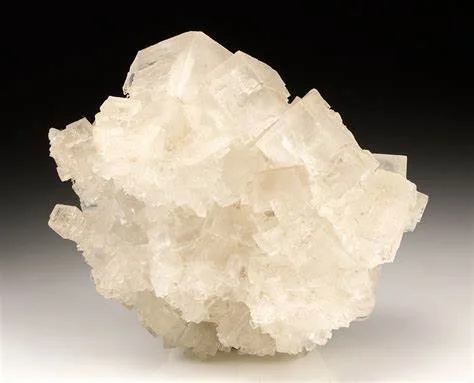
Appearance
Rock salt, also referred to as halite (/ˈhaelaɪt, ˈheɪlaɪt/), is a kind of salt that is the mineral (natural) form of sodium chloride (NaCl). Crystals of halite are symmetrical. The mineral is usually colorless or white, although it can also be gray, light blue, dark blue, purple, pink, red, orange, or yellow depending on the crystals’ structural or isotopic anomalies, impurities, and other components.
Geographical Distribution
Large amounts of halite can be found in Punjab, India, Ontario, Canada, Dax, France, southeast Russia, and New York, Texas, and Louisiana, United States.
Chemical Composition
Sodium (Na) and chlorine (Cl), in a one-to-one ratio, make up the element halite. This indicates that in its crystal lattice structure, there is an associated chloride ion (Cl–) for each sodium ion (Na+).

Uses
- Table Salt Production: Making table salt is one of the most well-known applications for halite. Halite is extracted or mined from natural sources, processed and purified to get rid of impurities, and then packed and sold for use in cooking.
- Food Seasoning: In cooking and food preparation, halite is frequently used as a seasoning and flavor enhancer. It gives a lot of different recipes that have a distinctively salty taste.
- Preservation and Pickling: For centuries, individuals have used salt to preserve food. It permits the preservation of meats, fish, and vegetables by preventing the growth of bacteria and other microbes. Additionally, pickling procedures employ it.
- Chemical Industry: An essential raw ingredient for the chemical industry is halite. It is utilized in the synthesis of several compounds, such as sodium carbonate (soda ash), sodium hydroxide (caustic soda), and chlorine.
- Water Treatment: Through ion exchange, halite is used in water treatment procedures to remove hardness ions like calcium and magnesium, hence softening the water.
- De-icing and Road Salt: In order to remove ice and snow from sidewalks, roads and highways in colder areas, halite is frequently used as a de-icing agent. It enhances the safety of winter driving.
- Agriculture: Halite is used in agriculture by applying it to fields to enhance soil structure and supply vital nutrients, such as sodium and chloride, for specific crops. It serves as a source of vital minerals for animal feed as well.
- Oil and Gas Drilling: In the oil and gas industry, halite is a component in drilling fluid. During drilling operations, it assists in maintaining pressure control in gas and oil wells.
- Construction and Building Materials: Halite is used in the building sector for a number of things, such as making plaster and plasterboard, filling in concrete and as a constituent in cement.
- Industrial Manufacturing: It is used in industrial processes like dyeing, paper, and textile manufacture. In metallurgy, it is also employed as a flux to aid in the removal of impurities from metals.
- Healthcare: Because halite saline solutions are compatible with the salt balance of the human body, they are employed in healthcare for intravenous fluids and procedures.
- Environmental Remediation: Halite facilitates the elimination of some toxins through ion exchange, which can be employed in environmental remediation operations to clean contaminated soil and groundwater.
- Art and Sculpture: Because halite is transparent and easily cut, it is used to make sculptures, artwork, and decorative items.
- Scientific Research: Scientists are interested in analyzing halite deposits in natural environments, like salt flats and pans, for the purposes of understanding astrobiology, geomicrobiology, and geology.
Table





